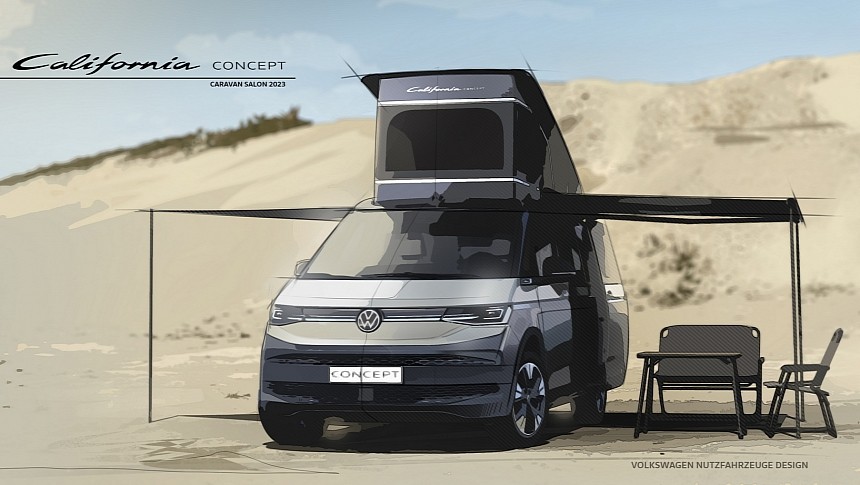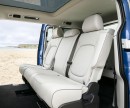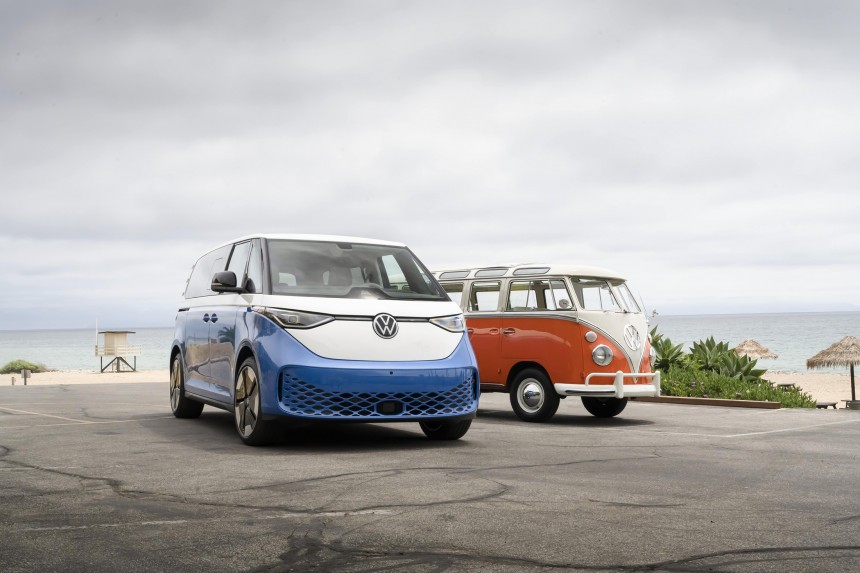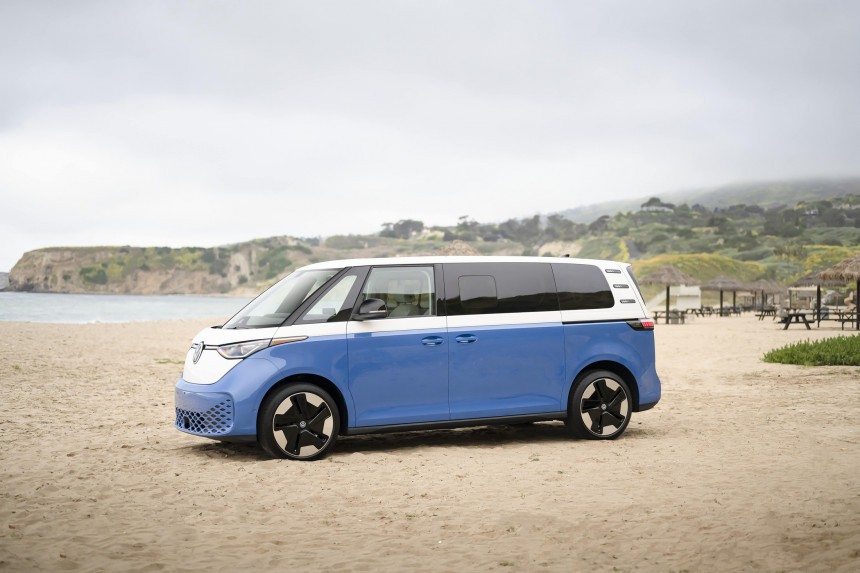When Volkswagen revealed the ID. Buzz, people saw it as the successor of the VW Bus (the T1 and T2). However, the electric MPV only shares the nostalgic styling and being an RWD with the first Transporter. Fans of the new vehicle who were hoping to have the California derivative will have a reality shock: the next camper will be offered as a version of the seventh-generation Multivan instead of the ID. Buzz. The explanation is that it would be too heavy – as most battery electric vehicles (BEV) are, but a little worse.
According to Edison Media, most buyers of the California bear a B-category driver's license, which allows them to drive vehicles that do not exceed the maximum authorized mass (MAM) of 3,500 kilograms (7,716.2 pounds). For them to be able to drive the ID. Buzz California, they would need at least a C1 driver's license. Although this is the market excuse for the vehicle not to be made, Volkswagen would also have a massive problem with range.
I have already discussed how crucial it is to make BEVs lighter for safety and efficiency matters. A more lightweight vehicle will not hurt other people as severely as a hefty one and will also demand less energy. At the same time, it was also obvious how difficult it would be to do that with the current battery technology. The low energy density cells present impose a massive battery pack. The longer the range the vehicle needs, the bigger the battery pack. Some car companies defend that a more widespread charging network would allow battery packs to be smaller, but that would only lead them to be fast charged more frequently. This procedure reduces the lifespan of the component, which costs a fortune to replace. Summing up, BEVs need better batteries, and they are yet to reach production lines.
A good example of what the hypothetical ID. Buzz California must have faced comes from the BMW i7. Its Protection derivative has a curb weight of 4,450 kilograms (9,810.6 pounds) and a range of 380 kilometers (236.1 miles). That's 1,735 kg (3,825 lb) more than the i7 xDrive60 and its 2,715 kg (5,985.6 lb). The regular electric sedan has a maximum range of 625 km (388.4 mi). That means the armor makes the BMW 63.9% heavier and gives it a range that is 38.7% worse. BMW even tried to ease that by limiting the top speed to 160 kph (99.4 mph), but that hurt the very purpose of the car: to help the attacked passengers run away before the bullets can cut through the armor. Volkswagen seems to want to avoid the same risk with its electric campervan.
Edison Media said that "the large pop-up roof alone, under which the second sleeping area for the travelers is located, weighs 100 kg." The California Concept also includes a kitchen and built-in cupboards. The second sliding door must also add more weight to the vehicle- Volkswagen did not disclose how much heavier the "California kit" made the T7 Multivan become. Its plug-in hybrid version already makes the scale suffer: its curb weight is 2,195 kg (4,839.2 lb), while its maximum total weight reaches 2,750 kg (6,062.7 lb).
Weight is not the only concern surrounding the project. Volkswagen may probably have lightweight solutions for the camper – such as carbon fiber components – but they would be expensive. Until the German carmaker can deliver something light and affordable, potential customers will have to make do with the Multivan California. While the concept version will be presented on August 25 in Dusseldorf, the production version should arrive in the summer of 2024. In other words, one year from now.
The disappointing bit is that Volkswagen had promised the ID. Buzz would have a California derivative. Although the company thinks it cannot deliver it right now, it is aware of the expectations and is working to solve the engineering challenges that it involves. The German carmaker is working closely with QuantumScape on a solid-state cell that could lower the mass of BEVs without range losses. They may also accept fast charges without the penalties ternary cells have, which would still make them depend on more charging stalls available wherever they were sold.
This is probably why Edison Media's sources said Volkswagen did not abandon the idea of an electric camper based on the ID. Buzz. It will just take the German carmaker a while to deliver one – around seven years more, to be precise. The ID. Buzz California should arrive only by the end of the decade, which reinforces that the German automaker is really waiting on better battery tech to offer such a product.
Considering QuantumScape plans to provide a solid-state platform, we may see it combined with several chemistries. The ID. California – as the future camper is also called – should count on a nickel-rich solution, which may help it weigh less. It may also present something completely different. In seven years, we may have more good news on batteries than solid-state solutions. It may also be the case that we do not have anything able to solve this weight problem and that another energy source for electric vehicles proves to be better. Hydrogen fuel cells, perhaps? We'll eventually find out how this story will unfold.
I have already discussed how crucial it is to make BEVs lighter for safety and efficiency matters. A more lightweight vehicle will not hurt other people as severely as a hefty one and will also demand less energy. At the same time, it was also obvious how difficult it would be to do that with the current battery technology. The low energy density cells present impose a massive battery pack. The longer the range the vehicle needs, the bigger the battery pack. Some car companies defend that a more widespread charging network would allow battery packs to be smaller, but that would only lead them to be fast charged more frequently. This procedure reduces the lifespan of the component, which costs a fortune to replace. Summing up, BEVs need better batteries, and they are yet to reach production lines.
A good example of what the hypothetical ID. Buzz California must have faced comes from the BMW i7. Its Protection derivative has a curb weight of 4,450 kilograms (9,810.6 pounds) and a range of 380 kilometers (236.1 miles). That's 1,735 kg (3,825 lb) more than the i7 xDrive60 and its 2,715 kg (5,985.6 lb). The regular electric sedan has a maximum range of 625 km (388.4 mi). That means the armor makes the BMW 63.9% heavier and gives it a range that is 38.7% worse. BMW even tried to ease that by limiting the top speed to 160 kph (99.4 mph), but that hurt the very purpose of the car: to help the attacked passengers run away before the bullets can cut through the armor. Volkswagen seems to want to avoid the same risk with its electric campervan.
Weight is not the only concern surrounding the project. Volkswagen may probably have lightweight solutions for the camper – such as carbon fiber components – but they would be expensive. Until the German carmaker can deliver something light and affordable, potential customers will have to make do with the Multivan California. While the concept version will be presented on August 25 in Dusseldorf, the production version should arrive in the summer of 2024. In other words, one year from now.
The disappointing bit is that Volkswagen had promised the ID. Buzz would have a California derivative. Although the company thinks it cannot deliver it right now, it is aware of the expectations and is working to solve the engineering challenges that it involves. The German carmaker is working closely with QuantumScape on a solid-state cell that could lower the mass of BEVs without range losses. They may also accept fast charges without the penalties ternary cells have, which would still make them depend on more charging stalls available wherever they were sold.
Considering QuantumScape plans to provide a solid-state platform, we may see it combined with several chemistries. The ID. California – as the future camper is also called – should count on a nickel-rich solution, which may help it weigh less. It may also present something completely different. In seven years, we may have more good news on batteries than solid-state solutions. It may also be the case that we do not have anything able to solve this weight problem and that another energy source for electric vehicles proves to be better. Hydrogen fuel cells, perhaps? We'll eventually find out how this story will unfold.






























